You have /5 articles left.
Sign up for a free account or log in.

Students in the pods at the College of Wooster
Matt Dilyard, courtesy of Little Diversified Architectural Consulting
Imagine living in a room smaller than a parking spot. Now imagine sharing that room with another person.
For students in one residence hall at the College of Wooster, this scenario is a reality. They live in pods much smaller than typical dorm rooms, with singles measuring about 72 square feet and doubles measuring about 108 square feet. (The most common area of a parking spot in the United States is about 161.5 feet.) The trend runs in contrast to dormitory rooms that -- either by choice of the college or the students -- feature lavish amenities.
The architectural firm Little Diversified Architectural Consulting helped design the pods based on the concept of tiny living, said Thomas Carlson-Reddig, the firm’s global practice leader. Proponents of tiny living seek to use small spaces with intentionality and simplicity, he said.
Tiny living is related to the tiny house movement, which promotes living simply in small homes. The philosophy of the movement can be traced back to Henry David Thoreau’s simple lifestyle at Walden Pond, Carlson-Reddig said.
In modern times, many credit the architect Sarah Susanka with popularizing the movement through her seminal 1998 book The Not So Big House: A Blueprint for the Way We Really Live (Taunton Press). More recently, Jeff Wilson, a professor at Huston-Tillotson University, called attention to the movement by living in a dumpster for a year.
Wooster began its experiment with tiny living in 2014, when it hired Little and BSHM Architects to transform an old schoolhouse into a new residence hall, said Doug Laditka, associate vice president of facilities management and development. Both architectural firms were enthusiastic about tiny living, and the idea of the pods quickly took shape, he said.
The old schoolhouse -- called the Gault Schoolhouse -- was already divided into classrooms that could be easily converted to suites, Laditka said. Each suite was designed to encompass a common area, a bathroom, a kitchenette and four or five pods, he said.
While the pods are only about 11.6 feet wide, they contain a good deal of furniture and amenities, Laditka said. Each pod comes with a built-in bed, a built-in desk, a closet area and a “crow’s nest” where students can place a TV or store unused objects, he said.
“The pods just provide everything students need in a small space,” Laditka said. “To me, that’s kind of what this modern living movement is all about. You have everything you need right there, and you don’t waste any space. But it doesn’t feel claustrophobic.”
If students do feel cramped, they can retreat to a common area in the residence hall that boasts bigger dimensions of 400 to 600 feet, Laditka said. The common areas were designed to bring students together, with features such as soft seating, flat-screen TVs and panoramic views from large windows, he said.
Since the residence hall opened, it has become a popular pick for upperclassmen in the room draw process, Laditka said. “It’s all upperclassmen. It’s absolutely the most sought-after residence hall for them to live in,” he said. “They love the small, personal sleeping space and the huge space that they get to share with their friends.”
Catherine Boyles, a senior at Wooster, said she loved living in the Gault Schoolhouse last year and looks forward to living there again this year. Still, her family members have expressed reservations about the size, she said.
“My family’s always like, ‘Oh, my gosh! That’s so small!’” Boyles said. “But once you live in a small dorm room, going to that isn’t a huge difference …. It’s nice to have the big common area. If we didn’t have the big common area to combat the smaller rooms, that would make it difficult.”
Kurt Holmes, interim vice president of student affairs and dean of students at Ohio Wesleyan University and former dean of students at Wooster, said the renovation of the Gault Schoolhouse was environmentally friendly. The pods were built from locally sourced materials, and the flooring is a composite of reused material, he said.
“There are some obvious green things we did by reusing materials and pieces of the facility,” Holmes said. “There was lots of attention to where things came from.”
While the College of Wooster began experimenting with tiny living in 2014, the College of Charleston is poised to unveil a renovated residence hall based on tiny living this fall. The Rutledge Rivers Residence Hall will feature the same pods but more than double the space -- 252 square feet -- per student. (The average on-campus apartment offers approximately 350 square feet per student.)
Monica Scott, vice president for facilities planning at Charleston, said she expects upperclassmen to vie for the chance to live in Rutledge. “Anybody can live there,” she said. “But I’m assuming this is going to be upperclassmen, because we go on a seniority basis with requesting student housing. It’ll be healthy to have them on campus.”
Michael Chew, executive president of the Residence Hall Association, said members of the student organization helped provide feedback on improving Rutledge to the architects from Little. For example, members came up with the idea of adding USB ports to the outlets so that students could charge their phones from the lofted beds, he said.
The Residence Hall Association didn't have any qualms about the size of the pods, Chew said. "They designed the rooms to be smaller, but the community area is bigger," he said. "So people will be drawn out of the rooms into the community space and have more interaction with the people they're living with."
Amanda Anyim, a sophomore in the College of Charleston Honors College, said she is excited to live in Rutledge this year as an underclassman. "I'm not going to lie, I love Rutledge," she said. "When I walked in, I thought it looked European-style, kind of like Ikea … I feel like I’m living the dream. It’s like living in a hotel."
The small square footage doesn't pose any issues, nor does the lofted bed, Anyim said. "I’m definitely getting my exercise climbing up on the bed, but it’s not a problem," she said.
Looking beyond traditional undergraduates, the architectural firm Svigals & Partners is even bringing tiny living to visiting faculty, researchers and international students. The firm is currently building microapartments aimed at faculty members and researchers with short-term appointments at Yale University.
“These microapartments were really the private sector’s vehicle into some other segments of the school populations with residential needs,” said Jay Brotman, a partner at Svigals. “In addition to undergraduate students, colleges and universities have faculty who may only come for part of the semester. They also have international student visitors who may only come for a semester or two.”
The microapartments will be 400 square feet and fully furnished, according to the white paper by Little and Svigals. A typical unit will contain a kitchenette equipped with a dishwasher and other appliances, as well as a fully furnished living room that will double as a sleeping area.




